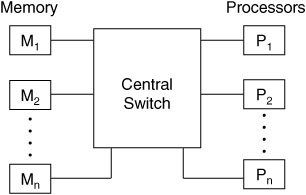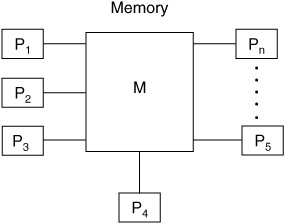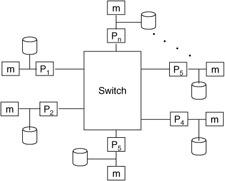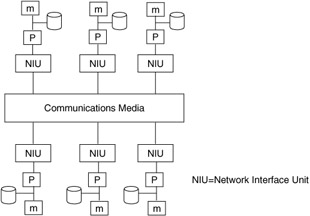2.6 Distributed and network architectures
|
| < Free Open Study > |
|
2.6 Distributed and network architectures
Not all systems consist of one computer. Modern systems used in academia, business, and government are more frequently being interconnected to form information-sharing systems or multiprocessing systems. These networks and computer interconnects are constructed by providing yet another input and output path for the computer to receive or send information. The input and output unit and controller for the network peripheral device are called a network interface unit (NIU) or processor bus. The function of these interface units and buses is to provide a seamless (typically) way for one computer to interact with another as if they were located in the same machine. Networks come in a variety of configurations-for example, the NIUs can be configured as a single global bus topology, as a central star or hub topology, as a ring topology, or as some hybrid. When interconnected in such ways over a relatively small distance (a single floor, building, or small organization), we have what is referred to as a local area network, or LAN. A LAN is used to interconnect a subunit of some larger organization or to interconnect a small number of users who need to share information. Beyond a LAN we have wide area networks and the Internet. Multiprocessor systems are interconnected using similar concepts. They are combined using shared buses or shared memory.
2.6.1 Computer to network interface elements
The network can be formed in many ways: It could have a central switching element, which could be a stand-alone computer acting as a router (see Figure 2.9a); it could share a central storage repository; or it could be connected using intelligent interface units into a communications medium. The configuration used depends on the degree of synchronization and control required, as well as the distribution between computers.

Figure 2.9a: Multiprocessor computer system with distributed memory.
The tightly coupled multiprocessor uses a shared central memory as the interconnection device (see Figure 2.9b). All processors on the network use the central memory to access and pass data among the interconnected processors. This distributed architecture provides an easy means to coordinate actions between processors. A distinction is that each processor does not have any local memory; all instructions and data are acquired from the shared memory bank. An improvement over this architecture is the loosely coupled multiprocessor. In this architecture each processor has some primary local memory and is interconnected via a shared secondary storage system. Each processor has its own operating system and local storage for programs and local data. Coordination occurs through the passing of data from one computer system to another through the shared storage device. The data exchange and signaling of transfers are handled through mechanisms such as messages or coordination of shared storage regions in the secondary storage medium.

Figure 2.9b: Multiprocessor computer system with Simms memory.
A further refinement removes the shared secondary storage device and replaces this with a communications switching element. The switch allows each of the disjoint computer systems to address and send information among themselves. Each computer system has its own local memory and can have additional secondary storage devices (see Figure 2.9c). Each computer communicates with interconnected systems by addressing the called system, forming a connection, and then initiating a conversation. This is analogous to how we converse over a phone system. The switching-based distributed system requires additional software at each site to coordinate access.

Figure 2.9c: Multiprocessor computer system with private local memory.
A further enhancement is to remove the central switch and replace it with a shared communications path (see Figure 2.9d). The path could be a shared bus, a ring, or a star medium. The interconnected computers are each required to have a medium interconnect unit, which controls the access to the medium. This architecture requires further control software and policies to allow for control over the shared medium. Only one computer at a time can be accessing the medium and sending information. We will see in subsequent sections how this software operates.

Figure 2.9d: Multiprocessor computer system with a communications subsystem.
2.6.2 Network bridges
We can further expand on the local area network or multiprocessing systems by introducing another networking control unit. To interconnect multiple networks or multiprocessing systems requires a bridge. (See Figure 2.10.) A bridge can be viewed as a speed-matching device to synchronize the traffic between networks. Bridges typically contain software and hardware to buffer incoming messages, to determine and rectify variances in addresses on interconnected networks, and to forward messages to the addressed unit. Routers and switches found in most medium to large network configurations fall into this category of device.

Figure 2.10: Connecting networks through a bridge.
|
| < Free Open Study > |
|
EAN: 2147483647
Pages: 136